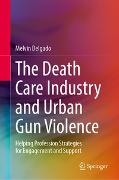Ulteriori informazioni
This book provides a unique foundation upon which to view how the involvement of the death care sector offers a potential route to take in practice and research in reaching urban communities of color dealing with gun-related deaths.
Gun violence in the United States is a salient national problem with virtually no day that goes by without it occurring. Where gun violence occurs, in turn, must be examined to facilitate understanding of how context influences the significance of the shooting. In the case of this book, the context is urban and death care sector (funeral homes, cemeteries, and houses of worship). Understanding how these settings shape public reactions help inform us as to how best to address this social and public health problem in the nation's urban centers and its consequences for communities.
The book addresses five interrelated goals that weave together a variety of themes to produce a vision and guidance needed for a new practice arena: (1) ground readers in the latest statistical information on urban gun violence in this country; (2) review existing approaches to preventing and intervening in community gun violence with a focus on cities; (3) uplift the importance of the death care industry in meeting the needs of families and friends of gun victims. Attention is also paid to how funeral homes have expanded their vision of services to aid their community; (4) provide readers with details and insights into how to develop collaborative projects with systems of care through a series of case illustrations; and (5) put forth community practice, education, and research recommendations for how best to prepare future practitioners wishing to work with the death care sector on other related community issues to better serve urban communities.
The Death Care Industry and Urban Gun Violence is a must-read for community psychologists, social workers, public health practitioners, community educators, sociologists, community medical providers, criminologists, and urban planners, as well as academics and students in these fields. Policy makers will also find the book of interest.
Sommario
Part 1. Setting the Foundation.- 1. Introduction to the Journey.- 2. Urban Community Gun Violence: A Multi-Faceted View.- 3. Last Rites & Violent Outcomes.- 4. Community Trauma.- Part 2. Case Illustrations.- 5. Chicago (Funeral Parlor).- 6. Boston (Cemetery Tombstone Destruction).- 7. Pittsburgh's Destiny of Faith Church Shooting.- 8. Jacksonville (Cemetery Violence & Social Media).- Part 3. Research, Education, and Practice.- 9. Research.- 10. Education (p.673).- 11. Practice.
Info autore
Melvin Delgado, PhD, is emeritus professor of social work at Boston University School of Social Work. Delgado has devoted his career to research and scholarship focused on urban issues and strategies. The subject of gun violence, particularly when centered on this nation’s urban centers and among residents of color, has been the focus of his scholarly attention over the past three years. Delgado has published approximately 40 books on a range of urban topics including community practice, gun violence, businesses, research, vacant gardens, and Latinos.
Riassunto
This book provides a unique foundation upon which to view how the involvement of the death care sector offers a potential route to take in practice and research in reaching urban communities of color dealing with gun-related deaths.
Gun violence in the United States is a salient national problem with virtually no day that goes by without it occurring. Where gun violence occurs, in turn, must be examined to facilitate understanding of how context influences the significance of the shooting. In the case of this book, the context is urban and death care sector (funeral homes, cemeteries, and houses of worship). Understanding how these settings shape public reactions help inform us as to how best to address this social and public health problem in the nation's urban centers and its consequences for communities.
The book addresses five interrelated goals that weave together a variety of themes to produce a vision and guidance needed for a new practice arena: (1) ground readers in the latest statistical information on urban gun violence in this country; (2) review existing approaches to preventing and intervening in community gun violence with a focus on cities; (3) uplift the importance of the death care industry in meeting the needs of families and friends of gun victims. Attention is also paid to how funeral homes have expanded their vision of services to aid their community; (4) provide readers with details and insights into how to develop collaborative projects with systems of care through a series of case illustrations; and (5) put forth community practice, education, and research recommendations for how best to prepare future practitioners wishing to work with the death care sector on other related community issues to better serve urban communities.
The Death Care Industry and Urban Gun Violence is a must-read for community psychologists, social workers, public health practitioners, community educators, sociologists, community medical providers, criminologists, and urban planners, as well as academics and students in these fields. Policy makers will also find the book of interest.

